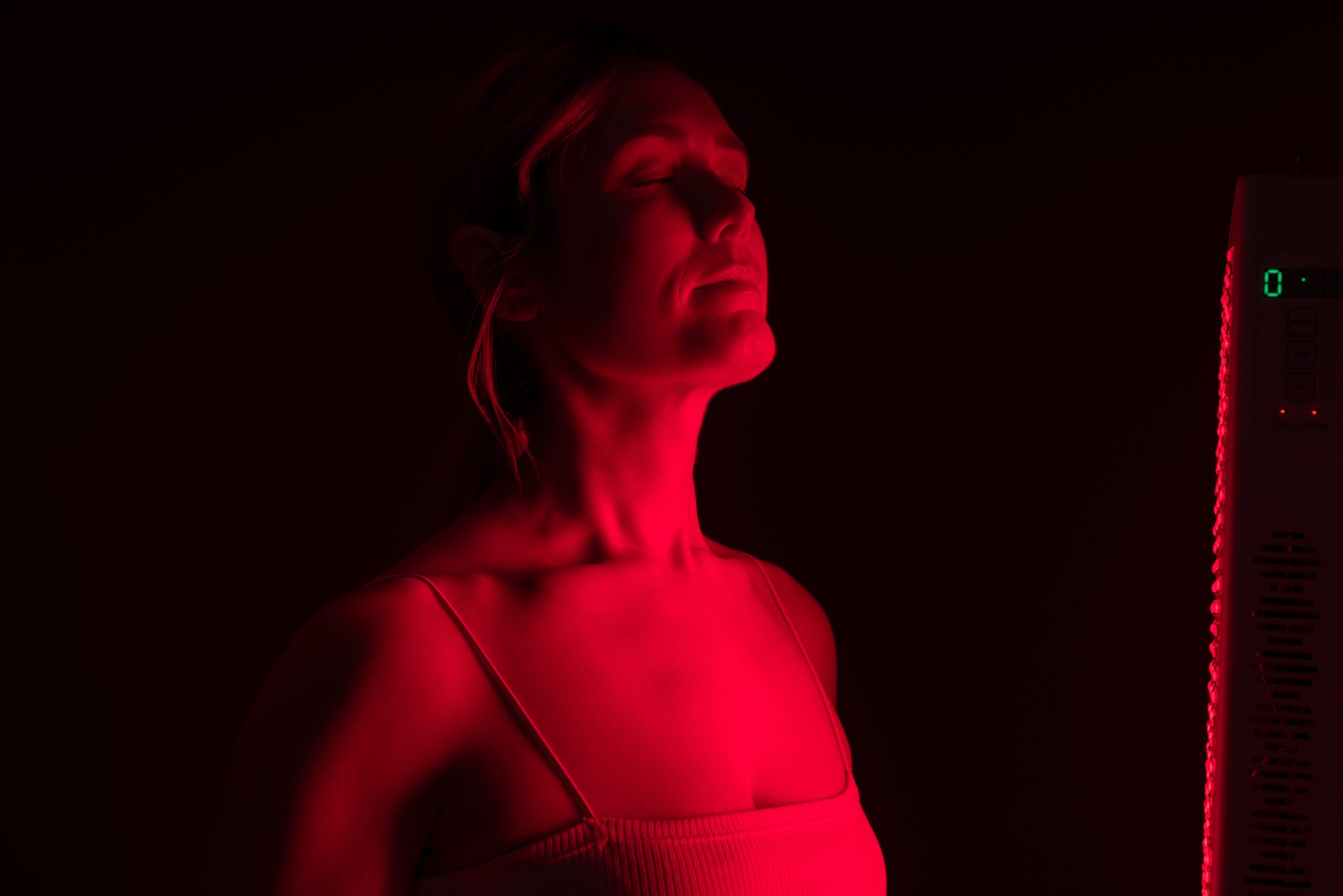Photobiomodulation & Integrative Cancer Care.
If we break apart the word photobiomodulation, we get photo (light), bio (life), and modulation (to change). This effectively encapsulates the essence of photobiomodulation (PBM) as a therapy that uses light to initiate beneficial changes in the biological processes of living organisms.
By applying specific wavelengths and intensities of light, PBM aims to enhance the body’s natural healing and regenerative capacities, influence cellular behavior, and modulate biological responses. In this blog post, you’ll learn how photobiomodulation works, what it benefits, and how I use it in my integrative cancer care practice, plus product recommendations and precautions.
Stimulating cellular energy production through PBM enhances the body’s natural repair processes, leading to faster wound healing and tissue repair.
How Does Photobiomodulation Work:
Photobiomodulation Therapy (PBMT) operates on the principle of using light, typically in the form of low-level lasers or LED devices, to stimulate, heal, regenerate, and protect tissue that has either been injured, is degenerating, or otherwise could use support in functioning optimally.
If the idea of using light to impact our health sounds really out of the box, consider that we humans can synthesize vitamin D from the sun, that our circadian rhythm and hormone cycles adapt to the light we see, and more. Different light frequencies do indeed have the ability to impact our bodies in various ways. The core mechanism that allows PBMT to exert its therapeutic effects is its ability to induce cellular photochemical reactions. Think of photosynthesis in plants, where light energy is converted into chemical energy to foster growth and health. When specific wavelengths of light are applied to human tissue, they are absorbed by mitochondrial chromophores, particularly cytochrome c oxidase, leading to an increase in mitochondrial efficiency and the production of adenosine triphosphate (ATP), the energy currency of the cell. This enhanced cellular energy production subsequently triggers a cascade of biological reactions that contribute to increased cell proliferation, migration, and the synthesis of anti-inflammatory mediators and growth factors. In short, PBMT essentially “charges up” our cells, enabling them to repair and regenerate more efficiently.

What Are The Benefits Of Photobiomodulation?
The benefits of Photobiomodulation (PBM) are comprehensive and diverse, thanks to its foundational influence at the cellular level. Given that our bodies are comprised of cells, PBM’s impact extends across the spectrum of physiological functions, offering many therapeutic advantages.
Pain Management
One of the most celebrated benefits of PBM is its ability to manage and reduce pain. By reducing inflammation and enhancing tissue repair, PBM can alleviate acute and chronic pain, including musculoskeletal pain, neuropathic pain, and arthritis-related pain. It is also beneficial in treating sports injuries, post-surgical recovery, and chronic inflammatory conditions.
Accelerated Tissue Repair and Wound Healing
Stimulating cellular energy production through PBM enhances the body’s natural repair processes, leading to faster wound healing and tissue repair. This makes it a valuable tool for treating skin wounds, burns, and surgical incisions and improving damaged muscle and connective tissue recovery time.
Improved Circulation (Detoxification)
By promoting vasodilation, PBM increases blood flow to the treated areas, crucial for delivering oxygen and nutrients required for tissue repair and removing waste products from the cells.
Neurological Benefits
Photobiomodulation has shown promise in neuroprotection and the recovery of nerve function, making it a potential treatment for neurodegenerative diseases, peripheral nerve injuries, and in the rehabilitation of patients with traumatic brain injuries.
Skin Rejuvenation:
The use of PBM in dermatology has shown positive effects on skin health, including reducing signs of aging, enhancing collagen production for wrinkle reduction, and treating acne and other skin conditions. It promotes healthier, more resilient skin through cellular rejuvenation. It fits well with a larger, non-toxic skin rejuvenation plan that may include platelet-rich plasma and IV therapy.
My Favorite Uses For Photobiomodulation:
In my practice, I have a few favorite ways in which I utilize the power of photobiomodulation:
Nervous System Healing
Disease encompasses not just physical symptoms but also the nervous system. Photobiomodulation offers significant promise in supporting the healing of the nervous system. This ranges from nervous system dysfunction related to stress and trauma to the aftermath of a traumatic brain injury or within the context of neurodegenerative diseases. This therapeutic approach can support the recovery of neurological function by improving cellular energy production, reducing oxidative stress, and promoting the synthesis of neurotrophic factors essential for nerve growth and health. My family is a big fan of using PBM for this application.
Colitis And IBD
In the treatment of colitis and inflammatory bowel disease (IBD), photobiomodulation can be extremely useful because it can modulate the immune response and reduce inflammation while also increasing rates of tissue repair and regeneration in the mucosal lining of the intestines—a double whammy that supports both healing and symptom relief without the use of pharmaceuticals.
Mucositis and Mouth Sores
Perhaps my favorite use for photobiomodulation is treating mucositis and mouth sores, common and excruciating side effects of cancer treatments such as chemotherapy and radiation therapy. By applying specific light wavelengths directly to the affected areas, PBM can reduce the severity and duration of lesions, alleviate pain, and accelerate healing.

What Photobiomodulation Devices Do I Recommend?
It can feel overwhelming to navigate the options available, and not all photobiomodulation devices are equally effective. For my patients, I provide individualized guidance and treatment plans, but generally speaking, these are my favorite photobiomodulation devices:
The Endolight Band:
I recommend this versatile device to everyone! Worn like a “watch,” the delight band allows the therapeutic light to hit the circulating blood via the wrist’s arteries. The endolight is versatile and has multiple settings, each wavelength or color impacting the body differently.
The WEBER Mat:
These mats are ideal for overall health and healing, offering a broad application of light therapy to support bodily functions and recovery processes. They come in small and large sizes and are versatile solutions you’ll find yourself reaching for all kinds of uses.
The PBM Pro
This device was designed for oral use, and I reach for it when I have mucositis or mouth sores. The PBM Pro delivers targeted light therapy to alleviate symptoms and accelerate healing.
The Weber Helmet:
The Weber Helmet is a photobiomodulation device shaped like a helmet that can be utilized for its effect on brain tumors and to aid in healing concussion, dementia, and neurodegenerative diseases.
Can I Utilize Photobiomodulation Therapy During Active Cancer Treatment?
I recommend photobiomodulation for post-cancer healing but only make recommendations during active disease for certain patients. This is something I tailor to each individual patient.
Summary:
Photobiomodulation is an excellent tool for anyone looking to heal at a cellular level and works exceptionally well for mucositis, gut health, and other inflammatory processes. There is also evidence of the benefits of PBM for nervous system healing. With various devices available, such as the Endolight Band, WEBER Mat, PBM Pro, and the Weber Helmet, individuals can access tailored PBM therapies that align with their specific health needs and conditions. If you are currently in active cancer treatment, be sure to consult with a knowledgeable practitioner before starting photobiomodulation therapy.